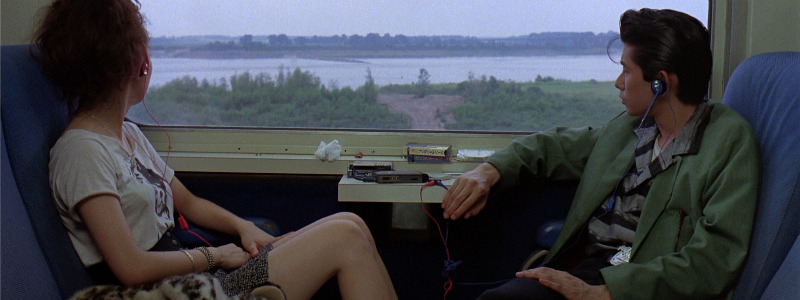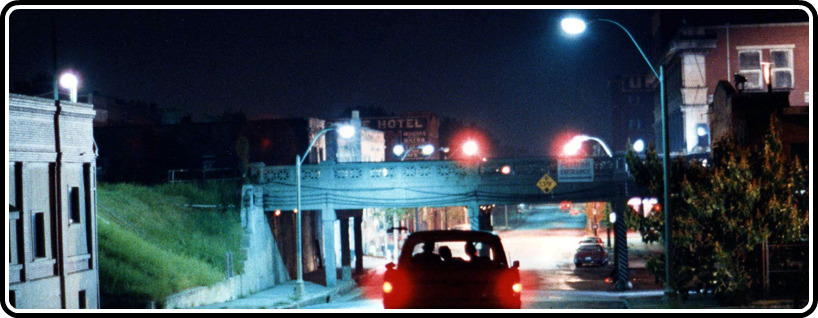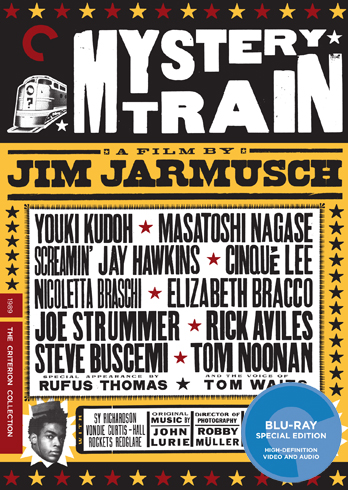“Was that a gun?”
“Probably. This is America.”
Jim Jarmusch’s ‘Mystery Train’ and I have had a tumultuous relationship with one another since it came out in 1989. I saw the film three times and each time I just disliked it to the point of hatred, because I didn’t feel connected with the characters, the film or the director’s vision at all. Fast forward to 2010 and ‘Mystery Train’ has been released onto Blu-ray by The Criterion Collection. And watching this film for the first time in about 7 years, it was as if I was watching this film for the first time in brand new eyes.
‘Mystery Train’ is a wonderful love letter to the city of Memphis, its people and the musical legacy it has given the world. It’s filled with characters that could easily carry one feature length film, but Jarmusch gives us a trilogy of stories within this film, showcasing some odd ball people and focuses on one night in Memphis and what happens to each one and how they are all connected in the ultimate scheme of things.
The first story, named “Far From Yokohama”, deals with Mitsuko and Jun (Youki Kudoh and Masatoshi Nagase), who are traveling through Memphis to see the sights, such as Sun Records and Graceland and disagree who the real king of rock and roll is (Carl Perkins or Elvis Presley). They ultimately stay the night at The Arcade Hotel, which is run by the night clerk (Screamin’ Jay Hawkins) and a bell hop (Cinqué Lee). Through the night, they talk more about Elvis and the comparison of the king to past kings, Buddha, the Statue of Liberty and Madonna herself. The scene ends with what sounds like a gunshot as the couple is getting ready to leave.
The second story, “A Ghost”, is about an Italian widow named Luisa (Nicoletta Braschi) who is stranded in Memphis and awaiting to go to her flight to get home to escort her husband’s coffin back to Italy. Through the night she’s hustled twice, first into buying an armful of magazines and then by a random guy at a diner (Tom Noonan). She is scared by the guy from the diner and his associate and runs into the nearby Arcade Hotel, where she bumps into Dee Dee(Elisabeth Bracco) who is leaving her husband in the morning and they decide to room together for the night to not be alone. She is kept awake all night, first by Dee Dee’s constant talking and then by the ghost of Elvis Presely himself. The scene ends with a gunshot and the two ladies parting ways from the hotel.
The third story, “Lost in Space”, deals with Johnny (Joe Strummer), who has just lost his job and his wife Dee Dee and has gotten drunk to dull the pain. He starts some trouble in the neighborhood bar with a gun that he has, so his friend Will Robinson (Rick Aviles) and his brother-in-law Charlie (Steve Buscemi) come to his aide and they drive around town all night. They go to a liquor store to get some more liquor and Johnny wounds the clerk in the store when he calls his friend Will a racist term. They run off, driving around and drinking more until finally settling into the Arcade Hotel. They all get more drunk, where Charlie realizes why the bell hop said ‘Danger Will Robinson’ to Will, piecing the reference to the sci-fi series ‘Lost in Space’. Johnny also tells Charlie that he and Dee Dee never did get married, so he isn’t his brother-in-law after all, which angers Charlie, considering he’s been running around town with someone who doesn’t even have that connection with him. The night ends with Johnny trying to kill himself and Charlie fighting him from doing it, shooting Charlie in the leg from the struggle.
The film is the first to be shot in color for Jim Jarmusch, but you’d be surprised to find that out, considering the palette of colors he uses to accentuate certain scenes and to paint the story along seems to come from an artist at the top of his game. From Screamin’ Jay Hawkins’ sharp red suit to the neon lights pulsating in the night from both the diner and the hotel, he uses them to give the viewer a little piece of that Memphis beauty. Even though the city of Memphis seems to be a ghost town, decrepit and rundown, he still shows the city such love and compassion, inviting us into a world that we might not be familiar with but ultimately want to become a part of.
The film comes with a great selection of supplements. Jarmusch never does commentary on his films because he leaves his film alone once it comes out, never watching it again. Instead he does a Q&A with Jim session for over an hour, giving answers to random fans that had emailed him about the film. There’s also a 17 minute excerpt of the Screamin’ Jay Hawkins documentary ‘I Put a Spell On Me’, which makes one want to own that film right away. Then there’s a 17 minute tour video of Memphis today, with some of the extras from the film, who are still living and working in Memphis today and showing why ‘Mystery Train’ did wonders for their city. And finally we have over 60 polaroids from the filming and a photo gallery that were from a making of book that came out with the film.

Aloof teenage Japanese tourists, a frazzled Italian widow, and a disgruntled British immigrant all converge in the city of dreams’”which, in Mystery Train, from Jim Jarmusch, is Memphis. Made with its director’s customary precision and wit, Mystery Train is a triptych of stories that pay playful tribute to the home of Stax Records, Sun Studio, Graceland, Carl Perkins, and, of course, the King himself, who presides over the film like a spirit. Mystery Train is one of Jarmusch’s very best movies, a boozy and beautiful pilgrimage to an iconic American ghost town and a paean to the music it gave the world.
Disc Features
DIRECTOR-APPROVED SPECIAL EDITION
- New, restored high-definition digital transfer, supervised and approved by director Jim Jarmusch (with uncompressed monaural soundtrack on the Blu-ray edition)
- Q&A with Jarmusch in which he responds to questions sent in by fans
- Original documentary on Mystery Train‘s locations and Memphis’s rich social and musical history
- On-set photos by Masayoshi Sukita, and behind-the-scenes photos
- New and improved English subtitle translation
- PLUS: A booklet featuring essays by writers Peter Guralnick and Dennis Lim, as well as a collectible poster






![Bergman Island (The Criterion Collection) [Blu-ray]](https://criterioncast.com/wp-content/uploads/2022/11/bergman-island-the-criterion-collection-blu-ray-400x496.jpg)
![This Is Not a Burial, It’s a Resurrection (The Criterion Collection) [Blu-ray]](https://criterioncast.com/wp-content/uploads/2022/11/this-is-not-a-burial-its-a-resurrection-the-criterion-collection-blu-ray-400x496.jpg)
![Lars von Trier's Europe Trilogy (The Criterion Collection) [The Element of Crime/Epidemic/Europa] [Blu-ray]](https://criterioncast.com/wp-content/uploads/2022/11/lars-von-triers-europe-trilogy-the-criterion-collection-the-element-of-400x496.jpg)
![Imitation of Life (The Criterion Collection) [Blu-ray]](https://criterioncast.com/wp-content/uploads/2022/11/imitation-of-life-the-criterion-collection-blu-ray-400x496.jpg)
![The Adventures of Baron Munchausen (The Criterion Collection) [4K UHD]](https://criterioncast.com/wp-content/uploads/2022/11/the-adventures-of-baron-munchausen-the-criterion-collection-4k-uhd-400x496.jpg)
![Cooley High [Criterion Collection] [Blu-ray] [1975]](https://criterioncast.com/wp-content/uploads/2022/11/cooley-high-criterion-collection-blu-ray-1975-400x496.jpg)
1 comment